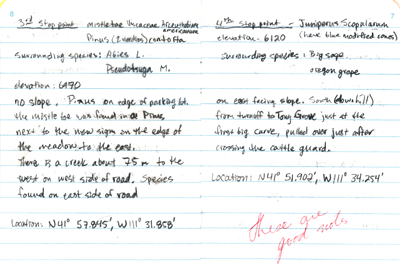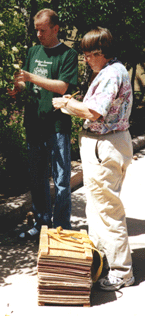Making Field Notes
Why Write Field Notes
Field notes give all the information about a plant that cannot be preserved with the specimen. Things like whether the plant was a tree or a shrub, how tall it was and what color the flower was when it was picked are all things that cannot be guessed at later from the specimen. Descriptions of the locality and the community of plants around the specimen are also things that you can't get later. Remember, it might be someone else looking at your specimen, not just you, and it might be 100 years after you collected it.


How To Write Good Field Notes
Write your field notes BEFORE starting to collect.
Train yourself to write neatly and clearly. Dream of the day when you become a botanist or botanical collector and your field notebook is used by someone else to type up your labels.
DO NOT RECOPY YOUR FIELD NOTES. Field notes are notes taken in the field. Remember, a few days (or weeks) later, what you think you saw may not actually be what you did see. Field notes can become a legal document for botanists so think of them that way from the start.
There are four parts to your field notes:
Information that identifies which specimen you are talking about and tells when it was collected and who collected it.
- Start by giving your plant a number. Use consecutive numbers so you can find them easily in your note book later. Some botanists collect more than 10,000 specimens so they need to have a good numbering system. Write your specimen number in the field note book and on the plant tag.
- If you have more than one specimen from the same plant then write more tags with the same number on them. The plant number is the only information you need on the tag.
- Add the date and who is with you (if anyone) to the field notes.
Information that describes the plant itself. This includes the features that will not be preserved with your specimen. For example, was the plant a tree or a shrub? How tall was it? What color was the flower when you picked it (flower color may change on drying)? A description of the bark.
Information that describes the location. Where did you collect the plant? The more accurately you do this, the better your collection. A topographic map may help. Also, use the odometer on your car. Remember to note what it reads when you go by landmarks on a collecting trip. Botanists require very accurate information about the location so they record the latitude (lat.), longitude (long.) and elevation using a GPS unit. You will need to include state and county with the location information.
Information that describes the ecological characteristics of the area (habitat description). There are two parts to this description:
- physical habitat - the type of soil, rocks, slope, elevation, aspect, moisture (for instance, whether the site is always wet, NOT whether it was pouring rain when you collected the plant).
- biological habitat - the other types of plants growing around your specimen. What kind of plant community is it growing in (open forest, opening in forest, closed forest, grassland, shrub-steppe, disturbed roadside. If you can name the other plants growing with your specimen, great!

